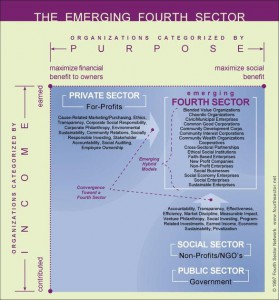
Richly deserving of careful attention.
The Three Traditional Sectors
Businesses create and distribute goods and services that enhance our quality of life, promote growth, and generate prosperity. They spur innovation, reward entrepreneurial effort, provide a return on investment and constantly improve their performance responding to market feedbacks. They draw on the skills, effort and ingenuity of individual workers, and share with them the economic value created by the enterprise.
Non-profit organizations give us ways to celebrate, build and protect the many human values that give rise to healthy, thriving communities. They have worked to ensure that all people have adequate necessities of life, including clean air, water, food and shelter; an equitable share of wealth and resources; and opportunity to develop their full physical, mental and spiritual potential. They create spaces to celebrate the joy of culture and artistic expression, and reveal opportunities for generosity. They have helped protect the environment, working to ensure that human capacities, technologies and organizations sustain and support, not systemically alter, degrade or destroy, the Earth, its diversity of life or the ecological systems that support life. They remind us that many species share this planet and depend on each other, and that humanity must not only care for itself, but must steward an entire world.
Governmental organizations protect and expand the principles of democratic freedom for both individuals and communities, protecting the public interest while at the same time ensuring a level playing field of opportunity and a common framework of laws and their enforcement at a scale that matches the scale of human activity. They have been granted, or they have presumed, the responsibility to provide for the common security and to make decisions to promote the best interest of society.
The Blurring of Sectoral Boundaries
Over the past few decades, the boundaries between the public (government), private (business), and social (non-profit) sectors have been blurring as many pioneering organizations have been blending social and environmental aims with business approaches.
There are many expressions of this trend, including corporate social responsibility, microfinance, venture philanthropy, sustainable businesses, social enterprise, privatization, community development and others. As this activity matures, it is becoming formalized as a ‘Fourth Sector’ of the economy. To better understand the emergence of the Fourth Sector, it is helpful to study recent shifts in organizational behavior across the three traditional sectors.

Businesses are dedicating more resources to delivering social and environmental benefits. Cause-based marketing, the triple bottom line, and corporate social responsibility are a few of the buzzwords that have come into usage in recent years as part of this trend (for more terms, see Figure 1). Meanwhile, public and social sector organizations are attempting to operate in a more businesslike method (see Figure 2 for examples of trends).

The Convergence of Organizations Toward a Fourth Sector
While the mission and method of many organizations in the business, government and nonprofit sectors are becoming steadily more similar, something more than simple blurring of the boundaries is occurring. Pioneering organizations in the three sectors are in fact converging toward a fundamentally new organizational sector that integrates social purposes with business methods: a Fourth Sector (Figure 3).
The Emergence of Hybrid Organizations
In addition to convergence, a second significant pattern of organizational activity has been occurring. The past few decades have seen a proliferation of new hybrid organizational models (Figure 3) formed to address a variety of societal challenges. These organizations consciously blend attributes and strategies from all sectors and thus resist easy classification within the boundaries of the three traditional sectors. But they share two common characteristics-—pursuit of social and environmental aims and the use of business methods—-that position them within the landscape of the emerging Fourth Sector. The following are examples of hybrid organizational models that have emerged in recent years. Many of these terms define overlapping activities, reflecting the state of fragmentation in which the emerging landscape finds itself today.
- Chaordic Organizations
- Civic and Municipal Enterprises
- Community Development Financial Institutions
- Cross-Sectoral Partnerships
- Faith-Based Enterprises
- Non-Profit Enterprises
- Sustainable Enterprises
- Community Wealth Organizations
- Social Enterprises
- Blended Value Organizations
- Social Economy Enterprises]

Constraints of Sectoral Boundaries
While many signs point toward the emergence of a Fourth Sector, a fully developed supportive ecosystem for Fourth Sector enterprises (legal structures, capital markets, technical assistance, etc.) is not yet in place. Consequently, “hybrid” entrepreneurs have little choice but to operate within the constraints of the three existing sectors. This often requires them to compromise their objectives, complicate their organizational structures, and invent new processes that distract their focus and deplete resources.
The plain fact is that the infrastructures that have come into being to support the three main sectors are not ideal for these hybrid enterprises. The track record of recent years has delivered a mixed message. On one hand, the private, public, and social sectors do have a certain amount of “give,” as evidenced by the considerable amount of organizational evolution that has taken place. However, their boundaries are pretty inelastic. As pioneering organizations in each sector implement new strategies and innovations in their attempt to meet the expectations of their stakeholders, they often find themselves pushing outside the boundaries of their respective sector. Often, they are unable to take these strategies as far as they would like because they are impeded by legal, capital, and other constraints. In the worst cases, they encounter significant obstacles and lose competitive advantage vis-a-vis their more traditional counterparts by straying too far from the standard rules of the road for their sector.
What is required is supportive infrastructure developed specifically to meet the needs of Fourth Sector organizations.
Request concept paper from source.
Phi Beta Iota: A great contribution. Could be enhanced by having a strategic analytic model for M4IS2, an open source philosophy across the board, a true cost economics foundation, and a means of valuing or at least tracking intangible value of contributed cognitive surplus etcetera.
See Also:
2012 PREPRINT FOR COMMENT: The Craft of Intelligence
2012 Integrity, Reflexivity, & Open Everything
Future of Multinational Intelligence & Operations
Graphic: Open Source Everything Logo
Paul Fernhout: Open Letter to the Intelligence Advanced Programs Research Agency (IARPA)
Reference: Strategic Analytic Model for Creating a Prosperous World at Peace
YouTube: Steele to Scowcroft at WW Center
Who’s Who in Collective Intelligence: Robert David STEELE Vivas



